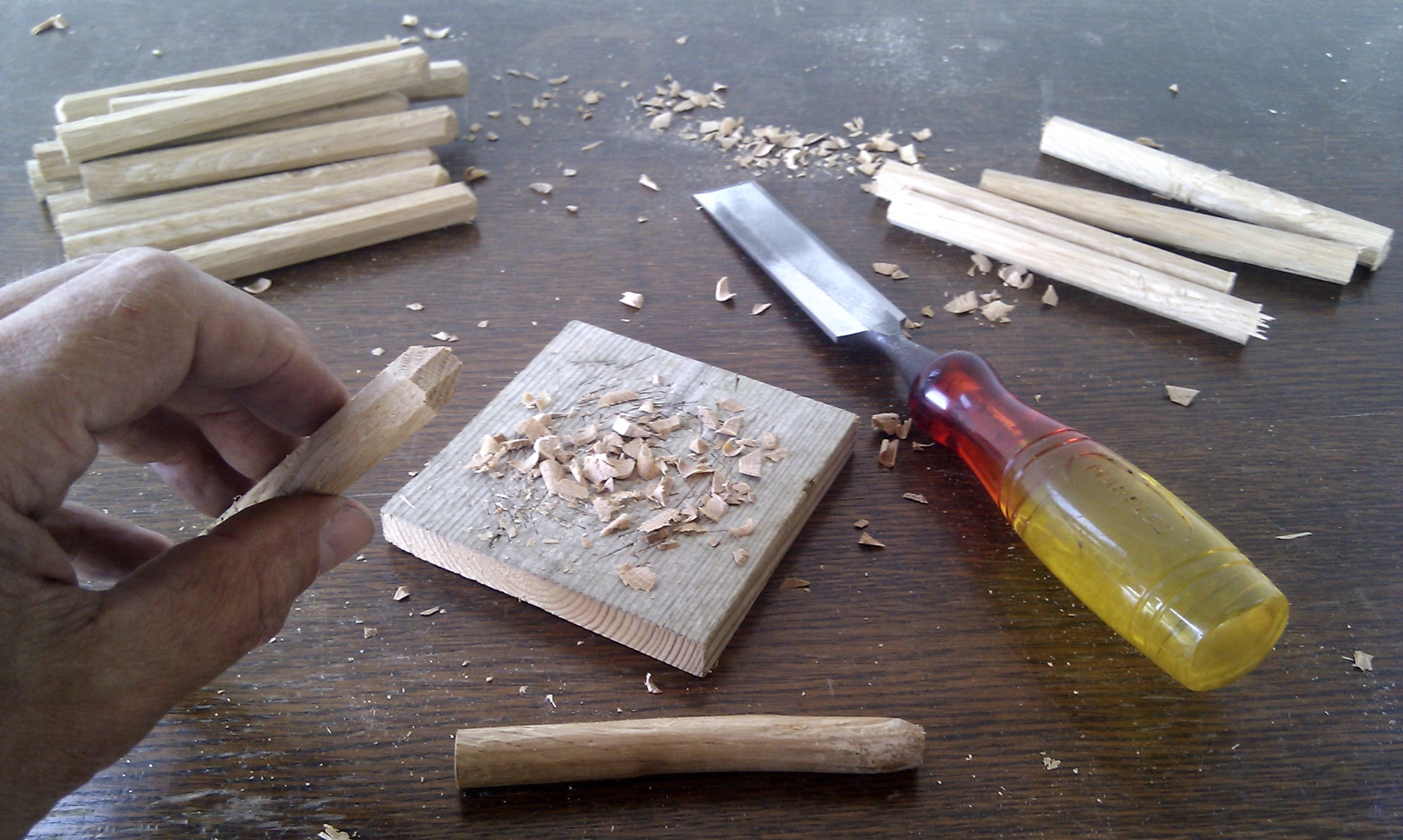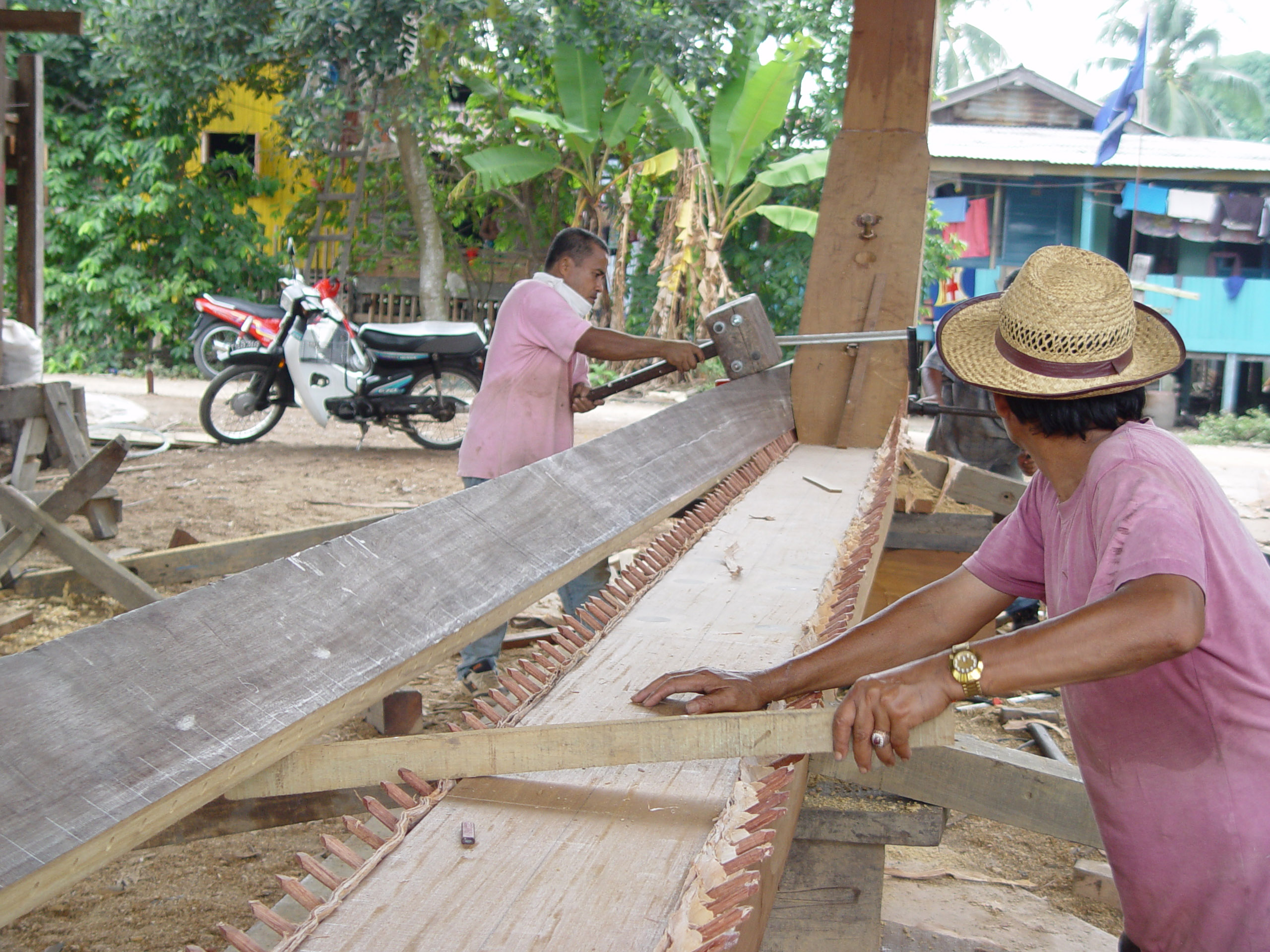Treenail on:
[Wikipedia]
[Google]
[Amazon]
 A treenail, also trenail, trennel, or trunnel, is a wooden peg, pin, or
A treenail, also trenail, trennel, or trunnel, is a wooden peg, pin, or
 The use of wood as a tenon can be traced back over 7,000 years, as archaeologist have found traces of wood nails in the excavation of early Germanic sites. Trenails are extremely economical and readily available, making them a common early building material.
The use of wood as a tenon can be traced back over 7,000 years, as archaeologist have found traces of wood nails in the excavation of early Germanic sites. Trenails are extremely economical and readily available, making them a common early building material.
 Ancient shipbuilding used treenails to bind the boat together. They had the advantage of not giving rise to "nail-sickness", a term for decay accelerated and concentrated around metal fasteners. Increased water content causes wood to expand, so that treenails gripped the planks tighter as they absorbed water. However, when the treenail was a different wood species from the planking, it usually caused rot. Treenails and iron nails were most common until the 1780s when copper nails over copper sheathing became more popular. As late as the 1870s, the merchant navy ships used treenails and iron bolts, while the higher class ships used the copper and yellow metal bolts and dumps. In the 1870s tradition, treenails were typically used in a ratio of four treenails to one bolt with the exception that sometimes the number of bolts was increased. In later corvettes, the ratio was changed to two treenails to one bolt.
Ancient shipbuilding used treenails to bind the boat together. They had the advantage of not giving rise to "nail-sickness", a term for decay accelerated and concentrated around metal fasteners. Increased water content causes wood to expand, so that treenails gripped the planks tighter as they absorbed water. However, when the treenail was a different wood species from the planking, it usually caused rot. Treenails and iron nails were most common until the 1780s when copper nails over copper sheathing became more popular. As late as the 1870s, the merchant navy ships used treenails and iron bolts, while the higher class ships used the copper and yellow metal bolts and dumps. In the 1870s tradition, treenails were typically used in a ratio of four treenails to one bolt with the exception that sometimes the number of bolts was increased. In later corvettes, the ratio was changed to two treenails to one bolt.
 A treenail, also trenail, trennel, or trunnel, is a wooden peg, pin, or
A treenail, also trenail, trennel, or trunnel, is a wooden peg, pin, or dowel
A dowel is a cylindrical rod, usually made of wood, plastic, or metal. In its original manufactured form, a dowel is called a ''dowel rod''. Dowel rods are often cut into short lengths called dowel pins. Dowels are commonly used as structural r ...
used to fasten pieces of wood together, especially in timber frame
Timber framing (german: Holzfachwerk) and "post-and-beam" construction are traditional methods of building with heavy timbers, creating structures using squared-off and carefully fitted and joined timbers with joints secured by large wooden ...
s, covered bridge
A covered bridge is a timber- truss bridge with a roof, decking, and siding, which in most covered bridges create an almost complete enclosure. The purpose of the covering is to protect the wooden structural members from the weather. Uncovered wo ...
s, wooden shipbuilding
Shipbuilding is the construction of ships and other floating vessels. It normally takes place in a specialized facility known as a shipyard. Shipbuilders, also called shipwrights, follow a specialized occupation that traces its roots to befo ...
and boat building
Boat building is the design and construction of boats and their systems. This includes at a minimum a hull, with propulsion, mechanical, navigation, safety and other systems as a craft requires.
Construction materials and methods
Wood
W ...
. It is driven into a hole bored through two (or more) pieces of structural wood (mortise and tenon
A mortise and tenon (occasionally mortice and tenon) joint connects two pieces of wood or other material. Woodworkers around the world have used it for thousands of years to join pieces of wood, mainly when the adjoining pieces connect at right ...
).
History and general use
 The use of wood as a tenon can be traced back over 7,000 years, as archaeologist have found traces of wood nails in the excavation of early Germanic sites. Trenails are extremely economical and readily available, making them a common early building material.
The use of wood as a tenon can be traced back over 7,000 years, as archaeologist have found traces of wood nails in the excavation of early Germanic sites. Trenails are extremely economical and readily available, making them a common early building material. Black Locust
''Robinia pseudoacacia'', commonly known in its native territory as black locust, is a medium-sized hardwood deciduous tree, belonging to the tribe Robinieae of the legume family Fabaceae. It is endemic to a few small areas of the United State ...
is a favorite wood when making trunnels in shipbuilding in North America and English Oak
''Quercus robur'', commonly known as common oak, pedunculate oak, European oak or English oak, is a species of flowering plant in the beech and oak family, Fagaceae. It is a large tree, native to most of Europe west of the Caucasus. It is wid ...
in Europe due to their strength and rot resistance, while red oak is typical in buildings. Traditionally treenails and pegs were made by splitting bolts of wood with a froe and shaping them with a drawknife
A drawknife (drawing knife, draw shave, shaving knife) is a traditional woodworking hand tool used to shape wood by removing shavings. It consists of a blade with a handle at each end. The blade is much longer (along the cutting edge) than it is d ...
on a shaving horse. Treenails are cut from a single piece of wood and perform well because of the natural grain. The grain of the treenail runs perpendicular to the grain of the receiving mortises which adds structural strength. Treenails are typically in diameter and are hand whittled with rough facets. The mortise is drilled smaller than the treenail to create a tight fit and take advantage of friction in the mortise. In cases where the treenail is or longer, the treenail should be shaped smaller than the other half. In the same case the mortise is drilled in two parts, with a smaller auger for the smaller part of the treenail and a typical auger for the standard part. Other trenails are tapered with the large end being longer than the mortise. After treenails are hammered into the mortise, they can be trimmed, split, and wedged with a small piece of oak that increases friction force. As an alternative to the wedge, the treenail can receive a plug or a punch to the center that expands the entire circumference. While this method prevents leaks by reducing gaps, plugs and punches are more likely to fall out in cold temperatures. Ideally, the nose of the treenail is driven 4–5 cm clear of the timber before being trimmed. Unlike metal nails, trenails can not be removed (without great effort) or reused. As the wood shrinks or expand the fibers create a friction that interlocks it into the mortise snugly. If a treenail breaks or fails but the wood it is fastening remains intact the remaining trenail can be cut out and replaced with a larger treenail that fits snugly. In addition, treenails have the ability to move over time and retain structural integrity.
Uses in building structures
Early mortise and tenon trusses with spans of less than used treenail fasteners. When used in a truss, the connecting mortises are drilled off center such that when the treenail is inserted it creates a tighter joint. Because of the large number of trenails required in a truss, the treenails can be turned on a lathe with a head and a tapered end, often kept extra-long for the tightest fit. The bottom chord often requires 2–3 pegs and is the weakest part of the truss. Hence the treenail can not prevent failure in spans of over . In cases where significant shrinkage may occur, it may be necessary to use iron U-straps or reinforcements.Uses in ships
 Ancient shipbuilding used treenails to bind the boat together. They had the advantage of not giving rise to "nail-sickness", a term for decay accelerated and concentrated around metal fasteners. Increased water content causes wood to expand, so that treenails gripped the planks tighter as they absorbed water. However, when the treenail was a different wood species from the planking, it usually caused rot. Treenails and iron nails were most common until the 1780s when copper nails over copper sheathing became more popular. As late as the 1870s, the merchant navy ships used treenails and iron bolts, while the higher class ships used the copper and yellow metal bolts and dumps. In the 1870s tradition, treenails were typically used in a ratio of four treenails to one bolt with the exception that sometimes the number of bolts was increased. In later corvettes, the ratio was changed to two treenails to one bolt.
Ancient shipbuilding used treenails to bind the boat together. They had the advantage of not giving rise to "nail-sickness", a term for decay accelerated and concentrated around metal fasteners. Increased water content causes wood to expand, so that treenails gripped the planks tighter as they absorbed water. However, when the treenail was a different wood species from the planking, it usually caused rot. Treenails and iron nails were most common until the 1780s when copper nails over copper sheathing became more popular. As late as the 1870s, the merchant navy ships used treenails and iron bolts, while the higher class ships used the copper and yellow metal bolts and dumps. In the 1870s tradition, treenails were typically used in a ratio of four treenails to one bolt with the exception that sometimes the number of bolts was increased. In later corvettes, the ratio was changed to two treenails to one bolt.
Uses in railroads
Similar wooden trenail fastenings were used as alternatives to metalspikes
The SPIKES protocol is a method used in clinical medicine to break bad news to patients and families. As receiving bad news can cause distress and anxiety, clinicians need to deliver the news carefully. By using the SPIKES method for introducing ...
to secure railroad
Rail transport (also known as train transport) is a means of transport that transfers passengers and goods on wheeled vehicles running on rails, which are incorporated in tracks. In contrast to road transport, where the vehicles run on a prep ...
rail-support "chairs" to wooden sleepers ( ties) in early Victorian times. Treenails were extensively used constructing railroads in North England.
References
{{Woodworking Woodworking Shipbuilding Timber framing